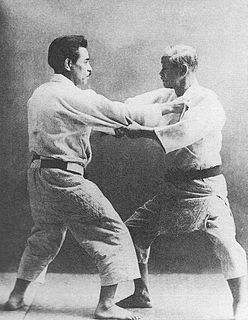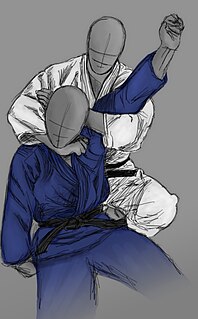
In combat sports, the north–south position is a ground grappling position where one combatant is supine, with the other combatant invertedly lying prone on top, normally with his or her head over the bottom combatant's chest. The north–south position is a dominant position, where the top combatant can apply effective strikes such as knee strikes to the head, or easily transition into various grappling holds or more dominant positions. Transitioning into side control can be done by first switching into a particular hold known as ushiro-kesa-gatame (後袈裟固) or reverse scarf hold, where the chest points to the side, and the opponent's arm is controlled similarly to kesa-gatame. The north–south choke is employed exclusively from this position.

Kesa-Gatame (袈裟固) is one of the seven mat holds, Osaekomi-waza, of Kodokan Judo. In grappling terms, it is categorized as a side control hold.
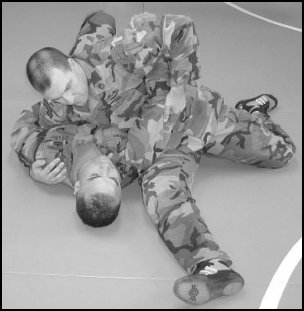
Kuzure-Kesa-Gatame (崩袈裟固) is one of the seven mat holds, Osaekomi-waza, of Kodokan Judo. In grappling terms, it is categorized as a side control hold.
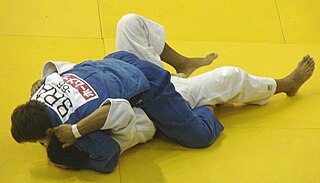
Tate-Shiho-Gatame (縦四方固) is one of the seven mat holds, Osaekomi-waza, of Kodokan Judo. In grappling terms, it is categorized as a mounted position.

Kuzure-Kami-Shiho-Gatame (崩上四方固) is one of the seven mat holds, Osaekomi-waza, of Kodokan Judo, a variation of Kami shiho gatame. In grappling terms, it is categorized as a north-south hold.

Ude-Hishigi-Juji-Gatame (腕挫十字固) is one of the official 29 grappling techniques of Kodokan Judo. It is one of the nine joint techniques of the Kansetsu-waza list, one of the three grappling lists in Judo's Katame-waza enumerating 29 grappling techniques. All of Judo's competition legal joint techniques are arm locks.

Ude-Hishigi-Ude-Gatame (腕挫腕固) is one of the official 29 grappling techniques of Kodokan Judo. It is one of the nine joint techniques of the Kansetsu-waza list, one of the three grappling lists in Judo's
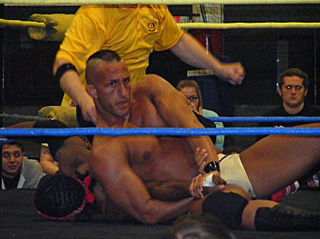
Ude-Hishigi-Waki-Gatame is an armlock and one of the official 29 grappling techniques of Kodokan Judo. It is one of the nine joint techniques of the Kansetsu-waza list, one of the three grappling lists in Judo's Katame-waza enumerating 29 grappling techniques. Falling directly to the mat while applying or attempting to apply the Waki gatame in competition is listed as an Hansoku-make by the International Judo Federation.
Ude-Hishigi-Hara-Gatame (腕挫腹固) is one of the official 29 grappling techniques of Kodokan Judo. It is one of the nine joint techniques of the Kansetsu-waza list, one of the three grappling lists in Judo's Katame-waza enumerating 29 grappling techniques. http://www.judoinfo.com/gokyo2.htm] All of Judo's competition legal joint techniques are arm locks.
Ude-Hishigi-Ashi-Gatame (腕挫脚固), sometimes called Ashi-gatame for short, is one of the official 29 grappling techniques of Kodokan Judo. It is one of the nine joint techniques of the Kansetsu-waza list, one of the three grappling lists in Judo's Katame-waza enumerating 29 grappling techniques.
Ude-Hishigi-Te-Gatame (腕挫手固) is one of the official 29 grappling techniques of Kodokan Judo. It is one of the nine joint techniques of the Kansetsu-waza list, one of the three grappling lists in Judo's Katame-waza enumerating 29 grappling techniques.
Ude-Hishigi-Sankaku-Gatame (腕挫三角固), also referred to as Ao muke gata ude hishigi (背中方腕挫) in the Canon Of Judo, is one of the official 29 grappling techniques of Kodokan Judo. It is one of the nine joint techniques of the Kansetsu-waza list, one of the three grappling lists in Judo's Katame-waza, enumerating 29 grappling techniques, and is also demonstrated by Kyuzo Mifune in the video The Essence of Judo.
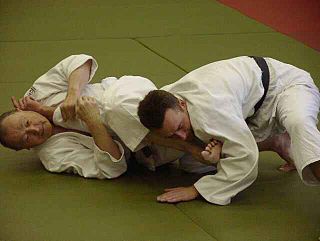
Ude-Hishigi-Hiza-Gatame (腕挫膝固) is one of the official 29 grappling techniques of Kodokan Judo. It is one of the nine joint techniques of the Kansetsu-waza list, one of the three grappling lists in Judo's Katame-waza enumerating 29 grappling techniques.
The Katame-waza ura-no-kata is a judo kata that can be considered as a complement to Mifune Kyūzō's Nage-waza ura-no-kata, but that instead focuses on counter-attacks to controlling techniques rather than throwing techniques. It was compiled by Itō Kazuo from techniques developed by other Japanese newaza experts, and is not an officially recognized Kodokan kata.
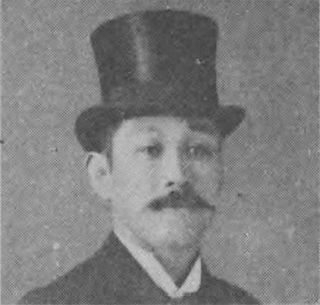
Mataemon Tanabe was a Japanese jujutsu practitioner and master of the Fusen-ryū school. He became famous for defeating multiple members of the Kodokan in challenge matches, and came to be considered one of the greatest modern jujutsuka.
Atemi waza (当て身技) or body-striking techniques were the strikes from the several ancient traditional Japanese jujitsu styles that were adopted in judo by its designer Jigorō Kanō in 1882 after a comprehensive study, accompanied by uke waza or defending blocks and parries. When judo further developed as a sports discipline, these techniques were excluded from its competition repertoire, which limits itself mainly to throws and holds : although taught within self-defense, kata and sometimes used within informal randori, striking techniques are forbidden in the sport judo competitions rules.
